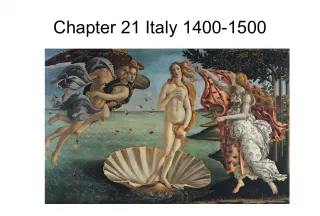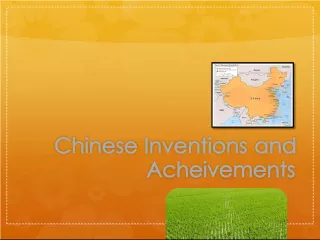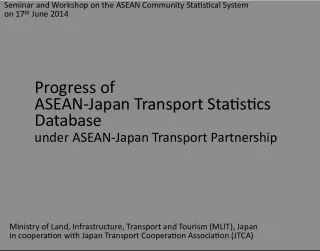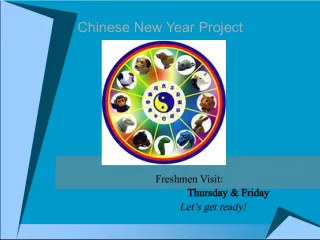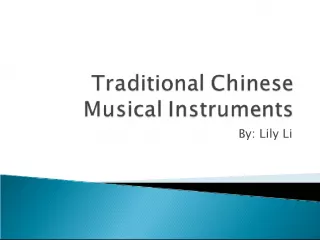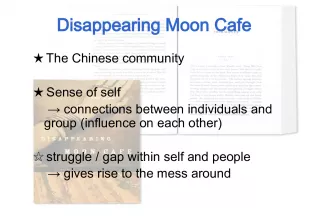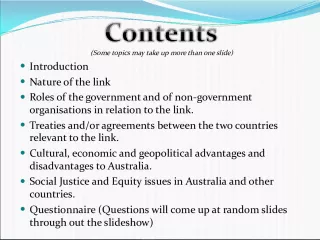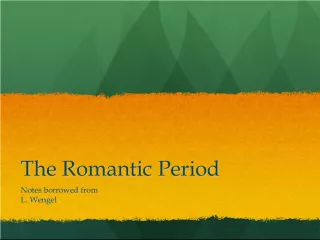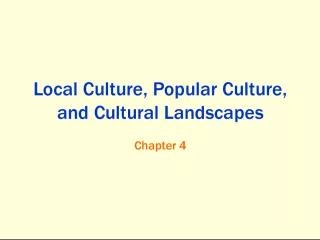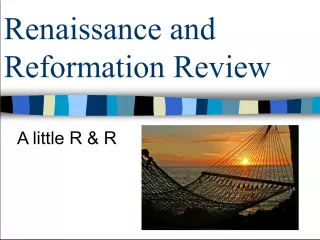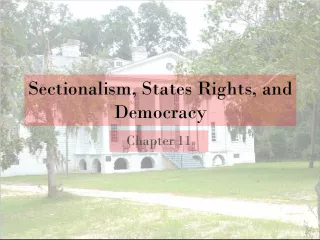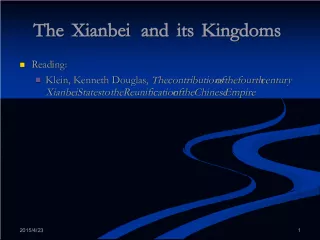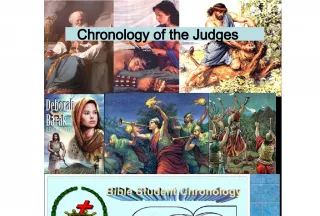The Yamato Period in Japan: Influence of Chinese Culture
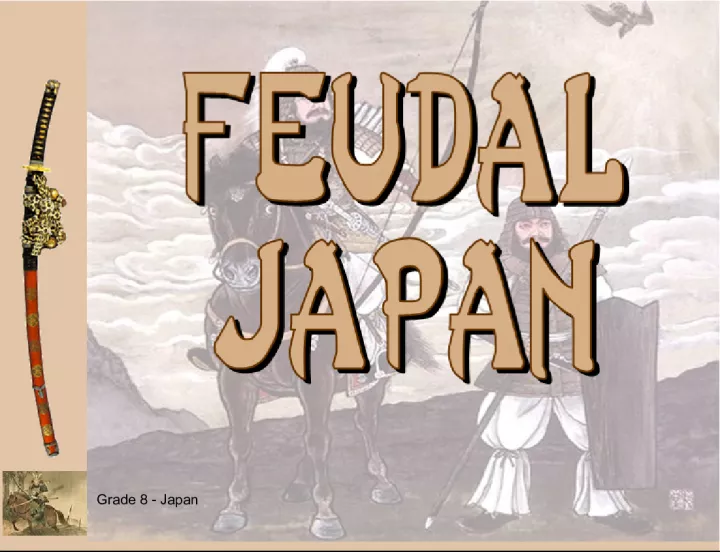

Learn about the Yamato Period in Japan, from 300 to 710 AD. This era saw the rise of great kings and the adoption of Chinese culture, including Confucianism, kanji characters, Buddhist sects, and Chinese art and architecture.
- Uploaded on | 1 Views
-
 adelem
adelem
About The Yamato Period in Japan: Influence of Chinese Culture
PowerPoint presentation about 'The Yamato Period in Japan: Influence of Chinese Culture'. This presentation describes the topic on Learn about the Yamato Period in Japan, from 300 to 710 AD. This era saw the rise of great kings and the adoption of Chinese culture, including Confucianism, kanji characters, Buddhist sects, and Chinese art and architecture.. The key topics included in this slideshow are Grade 8, Japan, Yamato Period, Great Kings era, Chinese culture, Confucianism, kanji characters, Buddhist sects, Chinese art, architecture, government structure,. Download this presentation absolutely free.
Presentation Transcript
1. Grade 8 - Japan
2. Grade 8 - Japan Yamato Period: 300 - 710 Yamato Period: 300 - 710 Yamato Period: 300 - 710 Yamato Period: 300 - 710 Great Kings era Great Kings era Began promoting the adoption of Chinese culture: Began promoting the adoption of Chinese culture: a Confucianism a Confucianism a Language ( kanji characters) a Language ( kanji characters) a Buddhist sects a Buddhist sects a Chinese art & architecture a Chinese art & architecture a Government structure a Government structure Began promoting the adoption of Chinese culture: Began promoting the adoption of Chinese culture: a Confucianism a Confucianism a Language ( kanji characters) a Language ( kanji characters) a Buddhist sects a Buddhist sects a Chinese art & architecture a Chinese art & architecture a Government structure a Government structure
3. Grade 8 - Japan Prince Shotoku: 573-621 Prince Shotoku: 573-621 Prince Shotoku: 573-621 Prince Shotoku: 573-621 Adopted Chinese culture and Confucianism a a Buddhist sects allowed to develop a a Created a new government structure: 17 Article Constitution in 604
4. Grade 8 - Japan Heian Period: 794-1156 Heian Period: 794-1156 Heian Period: 794-1156 Heian Period: 794-1156 Characteristics: Characteristics: a Growth of large landed estates a Growth of large landed estates a Arts & literature of China flourished a Arts & literature of China flourished a Elaborate court life [highly refined] a Elaborate court life [highly refined] ETIQUETTE ETIQUETTE a Personal diaries a Personal diaries e The Pillow Book by Sei Shonagon [10 th c] e The Pillow Book by Sei Shonagon [10 th c] a Great novel [11 th c] a Great novel [11 th c] e The Tale of Genji by Lady Murasaki Shikibu (1000 pgs.+) e The Tale of Genji by Lady Murasaki Shikibu (1000 pgs.+) a Moving away from Chinese models in religion, the arts, and government a Moving away from Chinese models in religion, the arts, and government Characteristics: Characteristics: a Growth of large landed estates a Growth of large landed estates a Arts & literature of China flourished a Arts & literature of China flourished a Elaborate court life [highly refined] a Elaborate court life [highly refined] ETIQUETTE ETIQUETTE a Personal diaries a Personal diaries e The Pillow Book by Sei Shonagon [10 th c] e The Pillow Book by Sei Shonagon [10 th c] a Great novel [11 th c] a Great novel [11 th c] e The Tale of Genji by Lady Murasaki Shikibu (1000 pgs.+) e The Tale of Genji by Lady Murasaki Shikibu (1000 pgs.+) a Moving away from Chinese models in religion, the arts, and government a Moving away from Chinese models in religion, the arts, and government
5. Grade 8 - Japan Heian Period: Cultural Borrowing Heian Period: Cultural Borrowing Heian Period: Cultural Borrowing Heian Period: Cultural Borrowing 1. Chinese writing 1. Chinese writing 2. Chinese artistic styles 2. Chinese artistic styles 3. Buddhism [in the form of ZEN] 3. Buddhism [in the form of ZEN] 4. BUT not the Chinese civil service system! 4. BUT not the Chinese civil service system! 1. Chinese writing 1. Chinese writing 2. Chinese artistic styles 2. Chinese artistic styles 3. Buddhism [in the form of ZEN] 3. Buddhism [in the form of ZEN] 4. BUT not the Chinese civil service system! 4. BUT not the Chinese civil service system!
6. Grade 8 - Japan Heian Court Dress Heian Court Dress Heian Court Dress Heian Court Dress
7. Grade 8 - Japan The Pillow Book by Sei Shonagon (diary) The Pillow Book by Sei Shonagon (diary) The Pillow Book by Sei Shonagon (diary) The Pillow Book by Sei Shonagon (diary)
8. Grade 8 - Japan The Pillow Book by Sei Shonagon (diary) The Pillow Book by Sei Shonagon (diary) The Pillow Book by Sei Shonagon (diary) The Pillow Book by Sei Shonagon (diary)
9. Grade 8 - Japan Tale of Genji ( first novel) Tale of Genji ( first novel) Tale of Genji ( first novel) Tale of Genji ( first novel)
10. Grade 8 - Japan Tale of Genji Scroll (first novel) Tale of Genji Scroll (first novel) Tale of Genji Scroll (first novel) Tale of Genji Scroll (first novel)
11. Grade 8 - Japan Feudal Society Feudal Society Feudal Society Feudal Society The emperor reigned, but did not always rule! The emperor reigned, but did not always rule!
12. Grade 8 - Japan Feudalism Feudalism Feudalism Feudalism A political, economic, and social system based on loyalty, the holding of land, and military service. Japan Japan A political, economic, and social system based on loyalty, the holding of land, and military service. Japan Japan Land - Shoen Shogun Daimyo Daimyo Samurai Samurai Samurai Peasant Peasant Peasant Peasant Land - Shoen Protection Loyalty Loyalty Food
13. Grade 8 - Japan Feudalism Feudalism Feudalism Feudalism A political, economic, and social system based on loyalty, the holding of land, and military service. Europe A political, economic, and social system based on loyalty, the holding of land, and military service. Europe King Lord Lord Knight Knight Knight Peasant Peasant Peasant Peasant Land - Fief Land - Fief Protection Loyalty Loyalty Food
14. Grade 8 - Japan Definitions: Definitions: Emperor The hereditary ruler of Japan. Emperor The hereditary ruler of Japan. Daimyo Feudal lords who were the leaders of regions of Japan. Daimyo Feudal lords who were the leaders of regions of Japan. Shogun The political leader of the military government of Japan. Shogun The political leader of the military government of Japan. Samurai The warrior class like the knights of medieval Europe. Samurai The warrior class like the knights of medieval Europe.
15. Grade 8 - Japan Oda Nobunaga (1534-1582) Oda Nobunaga (1534-1582) a a Banishes the last Ashikaga shogun a a Unifies a large part of Japan a a Banishes the last Ashikaga shogun a a Unifies a large part of Japan
16. Grade 8 - Japan R O E N S R O E N S
17. Grade 8 - Japan The Age of the Warring States: ( 1467 - 1568) The Age of the Warring States: ( 1467 - 1568) a a Castles built on hills in different provinces a a Power shifts from above to below a a Europeans arrive in Japan bringing firearms & Christianity a a Christianity & foreign trade flourish
18. Grade 8 - Japan Catholic Jesuits in Japan Catholic Jesuits in Japan Catholic Jesuits in Japan Catholic Jesuits in Japan Catholic missionaries first arrived in Japan in 1549 to start converting the upper classes, the daimyo and the samurai to Christianity. St. Francis Xavier Catholic missionaries first arrived in Japan in 1549 to start converting the upper classes, the daimyo and the samurai to Christianity. Catholic missionaries first arrived in Japan in 1549 to start converting the upper classes, the daimyo and the samurai to Christianity. St. Francis Xavier Catholic missionaries first arrived in Japan in 1549 to start converting the upper classes, the daimyo and the samurai to Christianity.
19. Grade 8 - Japan Toyotomi Hideyoshi (1536-1598) Toyotomi Hideyoshi (1536-1598) Becomes suspicious of European territorial ambitions Orders all European missionaries expelled from Japan Tries to invade Korea, but fails Reforms the government and social systems
20. Grade 8 - Japan Tokugawa Ieyasu (1542-1616) Tokugawa Ieyasu (1542-1616) Tokugawa Ieyasu (1542-1616) Tokugawa Ieyasu (1542-1616) a Appointed shogun by the Emperor a Appointed shogun by the Emperor Four-class system laid down with marriage restricted to members of the same class! Four-class system laid down with marriage restricted to members of the same class! Warriors Warriors Farmers Farmers Artisans Artisans Merchants Merchants
21. Grade 8 - Japan Tokugawa Shogunate Period Tokugawa Shogunate Period Japan closed off to all trade [except to the Dutch and Chinese] The Dutch were restricted to a small island in Nagasaki harbor a a Japanese Christians persecuted and Christianity was forbidden a a The government was centralized with all power in the hands of the shogun a a Domestic trade flourished a a Towns, esp. castle towns, increased a a Merchant class became rich! a a New art forms haiku poetry, kabuki theater
